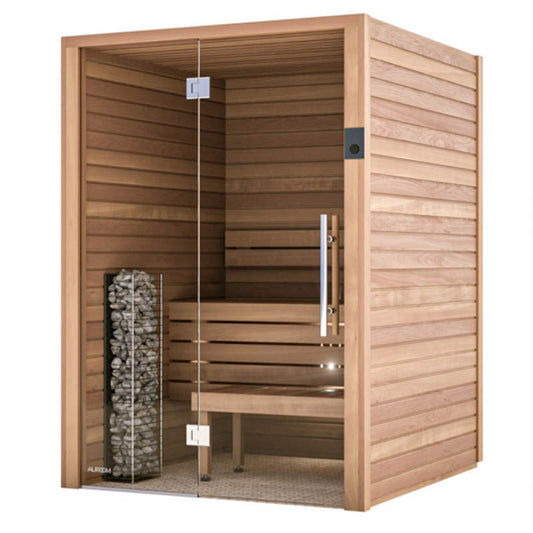The 8-Minute Rule for Traditional Sauna
The 8-Minute Rule for Traditional Sauna
Blog Article
An Unbiased View of Traditional Sauna
Table of ContentsLittle Known Facts About Traditional Sauna.Facts About Traditional Sauna RevealedTraditional Sauna Things To Know Before You Get ThisThe 10-Second Trick For Traditional SaunaSome Of Traditional Sauna
A lot of the weight lost in a sauna is water loss and is re-gained upon rehydrating. Without a question sauna can be a crucial component of a healthy and balanced weight loss program. To take a look at the distinctions in between typical and IR saunas, I will certainly divide these right into verifiable, theoretical, and fabricated differences.Thus, the most popular factor in the saunawhich goes to the ceiling straight over the sauna heateris commonly in between 185 and 190 F. Claims that a conventional sauna surpasses 200 F is just not true and not appropriate for electric saunas sold in the US. The temperature for a far-infrared sauna is usually established in between 120 and 140 F; nonetheless, unlike the typical sauna, the objective in and IR space is not to accomplish a high temperature.
Due to this, the temperature difference is almost unnecessary, since profuse sweating results in both sauna types, however the technique of heating the body is different. In an IR sauna the bather will certainly feel hot and will certainly sweat a lot, yet at much reduced temperature levels. Traditional Sauna. Thus, if the objective is to spend longer periods of time in the sauna, the IR sauna is an excellent choice

Traditional Sauna for Beginners

When the heat is attained, the elements cycle on and off to preserve the heat. Traditional Sauna. The majority of traditional sauna customers delight in pouring water over the rocks to produce heavy steam to elevate sauna humidity levels. The benefits of pouring water over the rocks include: making the space more comfy, dampening the nasal flows, and enabling the usage of aromatherapy by blending necessary oils with the water
In a far-infrared sauna, the warm front permeate the body to successfully heat up the body and increase the body core temperature. To accomplish this enhanced temperature, Far-infrared emitters create infrared power which is close to the very same wavelength as that which the body normally emitsoften described as the "Crucial Variety" of 7 to 14 microns), so the power is well received by the body.
When the power gets in the body, it triggers the body temperature level to raise and inevitably causes sweat. In an infrared sauna it is necessary for the emitters/heaters to continue to be on nearly frequently. Given that there is no mass of rocks to preserve warmth, the sauna will cool if the emitters turned off.
The Best Guide To Traditional Sauna
As discussed over, the sauna bather in an infrared space wishes to place himself in front of running emitters to obtain optimal benefit from the warmth. The home heating time for both rooms can be really different, depending on advice how the rooms are made use of. For a typical sauna, a bather ought to permit 30-40 minutes for you can try these out the space to achieve a wanted temperature and to properly pre-heat the rocks.
A well constructed sauna will typically accomplish a temperature level of 150-160 F in about 30-40 minutes. For hotter temperature levels, the room may require to warmth for a longer period.

Conventional saunas often tend to be bigger (hence utilize even more electrical power) than infrared saunas, although traditional saunas are certainly offered in one and two person dimensions. For a two-person standard sauna, 5x6 or 5x7 size is most prominent. The leading bench can easily seat 2 or 3 individuals and is also enough time to exist down during the sauna session.
The smart Trick of Traditional Sauna That Nobody is Discussing
The average cost per kWH of electricity in the united state is approximately $0.11 - Traditional Sauna, so a 4.5 kW heater will set you back approximately $.50 to run for one hour, if the heating unit runs constantly for one hour. Generally a sauna heating unit will certainly run for 75% of the first hour and 50% of succeeding hours on because the elements cycle once the established temperature level is attained
A 2 individual far-infrared space is normally literally smaller sized than a typical sauna, frequently about 4' x 4' or smaller. The IR heater is commonly 1.5-1.7 kW utilizing a 120 volt 15 amp plug-in service. Since the area can be utilized check out this site earlier than a sauna area, we will certainly presume the room is used for to of an hour consisting of warm up time.
There is a rarely gone over distinction in the social experience between the two rooms. While our society has actually shed some of the social benefit of the traditional sauna experience, it can be extremely socially satisfying. From family members time in the sauna, to heart-felt discussions with loved ones, to sauna partiesthe typical sauna experience can bring about intimate socializing.
Some Known Questions About Traditional Sauna.
Most higher end infrared rooms consist of colored light treatment, noise systems and full-glass fronts.
Report this page